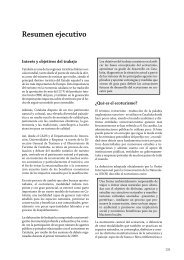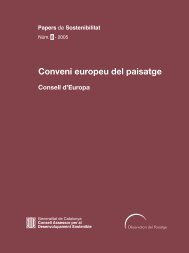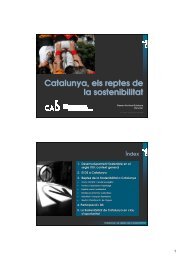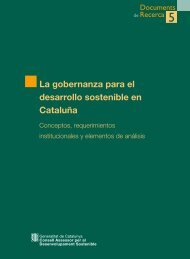Estratègies per al desenvolupament sostenible - Generalitat de ...
Estratègies per al desenvolupament sostenible - Generalitat de ...
Estratègies per al desenvolupament sostenible - Generalitat de ...
You also want an ePaper? Increase the reach of your titles
YUMPU automatically turns print PDFs into web optimized ePapers that Google loves.
Strategy ex<strong>per</strong>ience has ma<strong>de</strong> it clear that science-based and interdisciplinaryapproaches are helpful for i<strong>de</strong>ntifying soci<strong>al</strong>, environment<strong>al</strong> and economicproblems and options, but are not sufficient. They cannot address <strong>al</strong>l the issuesnor provi<strong>de</strong> access to <strong>al</strong>l necessary and useful information. Much of this is heldby individu<strong>al</strong>s and communities. Moreover, the <strong>de</strong>cisions nee<strong>de</strong>d are v<strong>al</strong>uejudgements. They need to be ma<strong>de</strong> with the participation of both “winners” and“losers”, so that some sort of agreement and commitment is reached on theoutcome. A people-centred approach is nee<strong>de</strong>d as a complement to the sciencebasedapproach. There is, therefore, a clear role for both technic<strong>al</strong> inputs byindividu<strong>al</strong> ex<strong>per</strong>ts and the broa<strong>de</strong>r involvement of many people in participatoryexercises – but at the same time not overbur<strong>de</strong>ning these people, resulting in“participation fatigue”. It is very important that a b<strong>al</strong>ance be struck betweenthese two approaches. The need for the “wi<strong>de</strong>st possible participation” inworking towards sustainable <strong>de</strong>velopment is noted in a number of chapters ofAgenda 21, <strong>al</strong>though there is little clarity about how to assure it.The pro<strong>per</strong> selection of participants is <strong>per</strong>haps the most critic<strong>al</strong> step in establishinga strategy process. The composition of participants will <strong>de</strong>termine both thelegitimacy of the strategy and its ability to <strong>de</strong>velop new i<strong>de</strong>as, insights andconsensus for action. Issues of representativeness, sampling and appropriate<strong>de</strong>grees of participation are important. A b<strong>al</strong>ance needs to be struck betweeninvolving as wi<strong>de</strong> a range of participants as possible to forge a broad-basedand durable consensus, and avoiding overloading the facilitating and manageri<strong>al</strong>capacities of those who are organizing the strategy process.Ex<strong>per</strong>ience of strategic planning over the past two <strong>de</strong>ca<strong>de</strong>s indicates a numberof requirements for effective participation. All of these requirements will need tobe well planned if the benefits of participation are to be re<strong>al</strong>ized. Otherwise,interest groups can be left out of the process, the complex organization<strong>al</strong> tasksof participation can be un<strong>de</strong>restimated, and the many prerequisites requiredmay not be in place in time. This entails various tasks, which might be coordinatedby the NSSD secretariat with a broad proto-group of stakehol<strong>de</strong>rs:(a) Mapping out the themes that may need to be worked on during the strategyprocess and by different groups of stakehol<strong>de</strong>rs: for example, sector<strong>al</strong>, crosssector<strong>al</strong>or comprehensive sustainable <strong>de</strong>velopment issues.156(b) I<strong>de</strong>ntifying the main levels at which policy and institution<strong>al</strong> changes will benee<strong>de</strong>d to address the above themes/issues – usu<strong>al</strong>ly: nation<strong>al</strong>, provinci<strong>al</strong>and loc<strong>al</strong>.
















